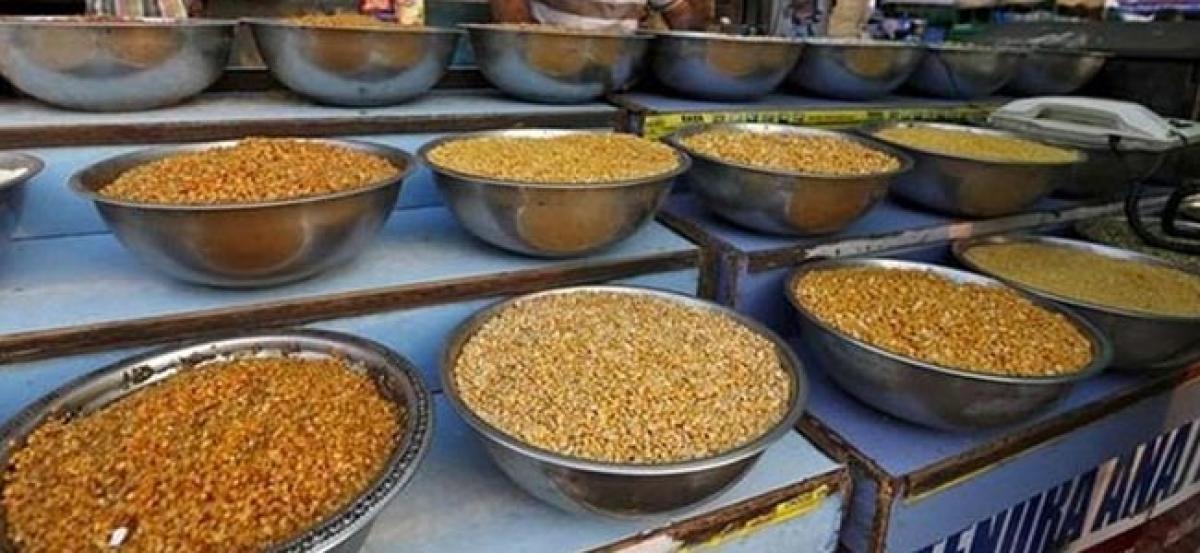Live
- Exhilarating ‘Benchmark’ of Venkat Changavalli
- Development activities worth `30 cr launched in Puthalapattu constituency
- Allegations against KTR baseless: BRS leader
- Megastar Chiranjeevi to Visit Allu Arjun’s Residence at 12 PM Today
- Nilima Rane: Trailblazer in Nursing
- Casual yet stylish office outfits for all-day comfort
- TTD to suspend all special darshans from January 10 to 19 amid Vaikuntha dwara darshans
- Naidu pats TDP leaders, cadres for enrolling 73L members
- Rupali Ganguly says for 20 years she never got an award
- Advanced anti-drone systems deployed for devotees’ safety at Mahakumbh
Just In

Shri Ram Vilas Paswan, Minister of Consumer Affairs, Food and Public Distribution today here brief the media about the initiatives taken by the Government to check the price rise of pulses.
Shri Ram Vilas Paswan, Minister of Consumer Affairs, Food and Public Distribution today here brief the media about the initiatives taken by the Government to check the price rise of pulses.
The Minister said that the main reason for unprecedented price rise in pulses has been two years of deficit rainfall and consequently drought-like situation in the entire country. Due to this, the production of pulses was less as compared to that in previous years, as a result of which there was huge demand-supply gap. This provided an opportunity for middlemen and hoarders to stock and speculate the price of pulses.
Highlighting the statistics, the Minister said that the production of pulses sharply declined from 192.5 LMT in the year 2013-14 to 171.4 LMT in 2014-15 and to around 165 LMT in 2015-16. Though the import figures increased to 45 LMT in 2014-15 and 58 LMT in 2015-16, there was a net deficit in supplies.
Shri Paswan said that fortunately, this year, there has been good rainfall and the acreage of pulses has gone up. It is expected that the production of pulses will exceed 200 LMT in the year 2016-17.
The Minister said that Government took various steps to check rising prices of pulses by banning export and allowing import of pulses at zero duty. In the last two years MSP of pulses has been increased considerably by providing bonus. The MSP for Arhar was increased from Rs. 4350 per qtl. in the year 2014-15 to Rs. 4625 per qtl. in the year 2015-16. This year, the MSP of Arhar has been increased by Rs. 425 per qtl. and now it is Rs. 5050 per qtl. Similarly, in case of Urad the MSP now is Rs. 5000 per qtl., an increase of Rs. 650 per qtl. in two years. The MSP for Moong is Rs. 5225 per qtl., an increase of Rs. 625 per qtl. in the last two years.
Buffer Stock
Shri Ram Vilas Paswan said that Government took a decision to create buffer stock of 1.5 LMT pulses. However, looking at the trend of prices and demand-supply gap, it was increased to 5 LMT and then to 8 LMT. Now as per the decision of Cabinet Committee on Economic Affairs today, the buffer stock has been increased to 20 LMT. The salient features of buffer stock are as follows:
10 LMT will be created through domestic procurement operations to be undertaken by FCI, NAFED and SFAC.
10 LMT will be created through import of pulses which will be through G2G contract and/or spot purchase from the global market.
The stock position of buffer stock at present is 3 LMT, out of which 1.81 LMT is imported pulses and 1.19 LMT is domestic procurement.
The allocation of pulses from buffer stock would be made to States and Central Agencies.
Pulses would be released through Open Market Sales as well.
Professional agency for management of buffer stock may be engaged.
Shri Paswan said that all this has been possible due to personal intervention of Prime Minister who took the issue of price rise on high priority and formed a High Level Committee under the Chairmanship of Finance Minister. Enhancing the buffer stock to 20 LMT was one of the recommendations of this Committee, which the Cabinet Committee on Economic Affairs approved today.

© 2024 Hyderabad Media House Limited/The Hans India. All rights reserved. Powered by hocalwire.com







